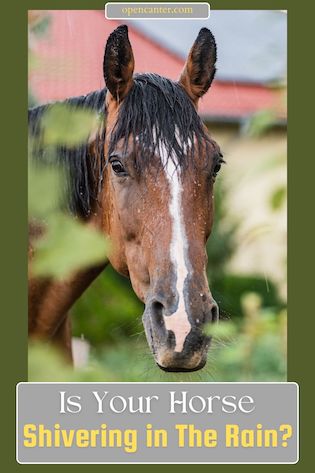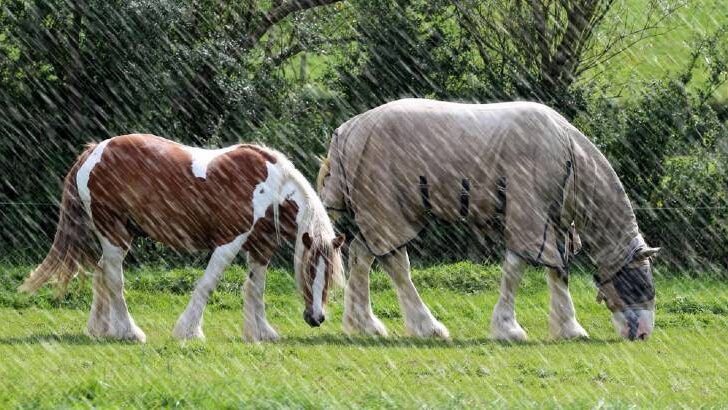Affiliate Disclaimer
As an Amazon Associate I earn from qualifying purchases. It helps me keep the website going. Thank you for your support.
Whether for pleasure, sport, or both, owning horses brings much joy to many people. While they’re lovely animals to keep, they’re also complicated. They have unique and specific needs that are always changing. For example, a horse shivering in the cold rain may need a blanket, but that’s not always the answer.
Have you recently discovered your horse shivering in the cold rain? There are a few possible solutions here, so you must first get to the root of the problem. Read on to learn why your horse may be shivering and how you can help them.

Why is Your Horse Shivering in the Cold Rain?
While your horse may be shivering for a few reasons, the cold, wet environment is often the culprit. A horse’s coat is designed to help them insulate against cold temperatures and high winds. This is why you often see horses with long coats outside in the winter with no blanket.
Some people are extremely concerned by this. Sadly, some people will simply neglect their horses in the cold. But, this is far from always being the case. A long, thick winter coat can actually perform better than a blanket sometimes.
A horse with no blanket will become cold if their coat gets soaked all the way through from standing in the rain. Once they can no longer insulate themselves, they will start shivering. This is their body’s attempt to generate some heat.
If you find your horse shivering in the cold rain, the first thing you should do is determine the source of the shivering. There are a few ways to check if your horse is indeed too cold:
- Check his ears. Cold ears usually mean a cold horse. When doing this, make sure your hands are at room temperature themselves! If your hands are ice cold, his ears will likely feel warm no matter what.
- If wearing a blanket, check underneath. They should be dry and warm to the touch. If they are wet under the blanket, it’s probably lost its waterproofing abilities.
- If not wearing a blanket, the temperature of his skin can still indicate that he’s uncomfortably cold.
- Did you see if he was running around? A cold horse may run around to try and warm up.
How to Warm up A Horse Shivering in the Cold Rain
If you’ve just pulled your wet, shivering horse inside you should try to get him warm as soon as possible. Larger problems like hypothermia or colic can result if a horse is cold and shivering for too long.
- Start by drying him off as best as you can. Use large, absorbent towels or blankets.
- Put a cozy blanket on him, at least until he warms and stops shivering.
- Keep him inside a warm, dry stall or shelter.
- Take note of his vitals – temperature, pulse, and respiration. Monitor closely if they aren’t normal.
- As he warms and for a while after, watch for signs of lethargy, fever, lack of appetite, and other abnormalities.
Once your horse is warmed up, it’s time to determine why they got too cold and make the necessary changes.
Keeping Your Horse Warm
A horse shivering in the cold rain or cold temperatures is a good sign that something isn’t quite right. The following are some steps you can take to ensure your horse stays warm while outside in the cold or rain:
- Free choice hay. Constant eating and abundant fiber are good for a horse’s teeth and digestive system, but also their internal temperature. Horses slowly grazing on hay will stay warmer at their core thanks to the constant digestion.
- Ensure they have adequate shelter when outside. Even if they stay inside at night, they need somewhere warm and dry to retreat when outside. A fully enclosed run-in is a great option, especially for horses outside 24/7. You can read more about providing shelter for your horse here.
- If a run-in isn’t possible, each paddock should have a shelter with three walls for optimal protection from the elements.
- Blanketing may need to be adjusted. A waterproof rain sheet is the first step if you’re expecting heavy rains. If it’s also very cold out, an insulated blanket underneath the rain sheet may also be in order.
- While blankets can be life savers in harsher weather, you must be careful not to over-blanket, too. If a horse sweats under its blanket, this can cause a chill and will also lead to discomfort and shivering.
Other Reasons Horses Shiver
While a horse shivering in the cold rain is pretty common, this isn’t the only reason a horse shivers. If they’re simply cold, you likely don’t have to worry as long as you get them warmed up right away.
Other causes may have more serious implications though, so it’s important to keep an eye out. For example, a horse may shiver if they’re exhausted. This can include heat exhaustion, and/or being worked too hard or for too long.
Other causes of shivering or trembling can include:
- Severe, body-wide pain or illness
- Shock from a traumatic accident or event
- Fever
- Impending colic
- Too much stress
- Recovering from anesthesia
If you’re worried their shivering may be caused by one of the above and not just the cold, watch and check for other signs. These things can include:
- Depression, dullness, and lethargy
- Other signs of colic, such as pawing, laying down, sweating, looking at their stomach
- Weak or wobbly on their feet
- A temperature above 101.5 degrees Fahrenheit
- Difficulty breathing
- Local muscle twitching
If you notice any of these things or are at all worried, it’s always best to call your vet. They can do more in-depth tests and exams to determine what may be going on. For things like a fever or colic, catching it early is crucial.
What You Need to Know About Shivers
Whether it’s from the cold or something else, lots of horses will shiver from time to time. Whether it’s a simple blanket or a visit from the vet, you can usually treat the cause of shivering. However, there are some cases where a horse shivering is more chronic, and could be neurological. This condition is known simply as “Shivers.”
Shivers
Shivers stem from damage to certain nerve cells in a specific area of the horses’ cerebellum. It’s been found in a variety of breeds, including thoroughbreds, drafts, warmbloods, and quarter horses.
Males and females can both have it, though studies have found that male horses standing 16.3hh or more are most at risk. There is no specific treatment or cure, though many afflicted horses can lead happy lives under the right conditions.
Signs of Shivers usually appear in a horse by the age of five and will progress as they get older. Clinical signs of Shivers include:
- Hyperflexion in the back end – the horse routinely holds its back leg(s) up and away from its body when baking up.
- Hyperextension – the horse places its feet further back than normal when backing up.
- Most of the time, both back legs are affected.
- These symptoms are rarely observed in the front legs, but it’s possible.
- These symptoms also rarely appear when the horse is moving forward; if they are, it’s a sign of a more severe case of Shivers.
- Affected horses will likely be resistant to having their back feet picked up and/or worked on by the farrier.
- Muscle atrophy, primarily in the thigh muscles, will develop as the horse ages and the disease progresses.
It can be tough to diagnose Shivers right away as these things can all potentially be explained by other issues. The diagnostic process will involve observing the clinical signs and ruling out other explanations.
Preventing and Managing Shivers
Prevention can be tough as a specific cause has yet to be identified, though a genetic predisposition has been suggested. Some research suggests that vitamin E may help prevent the disease in horses who are at risk. This is because vitamin E supports healthy nerve and muscle tissue, which are most affected by the condition.
If your horse is diagnosed with this disease, it’s not a death sentence! Many horses can thrive with diligent owners and the right tactics. To best manage the condition, the following things are imperative:
- Maintain a consistent fitness program.
- The more turnout the better; stall time should be minimal. Plenty of movement has been shown to minimize the signs and symptoms.
- Learn your horses’ most common triggers and limit/manage them.
- Reduce stress and excitement as much as possible.
- Supplementing with selenium and vitamin E may help, but follow your vet’s recommendations here.
Unfortunately, this is a progressive disease so your horse can get worse over time. Those with more pronounced conditions may see a decline in performance. But, this doesn’t mean they can’t still thrive in the right environment, they may just have to retire from competition.
Final Thoughts
It may be sad or scary to see your horse shivering in the cold rain, but there’s no use panicking! If they’re cold, get them warm and dry. If symptoms persist, it’s worth chatting with the vet. The first steps usually include blankets or shelter upgrades. Don’t beat yourself up if your horse comes in cold – horses are forgiving and they’ll forget in no time!




